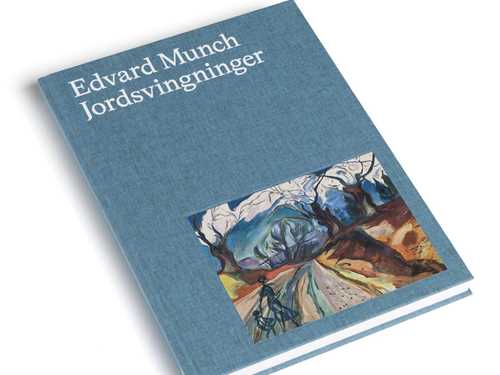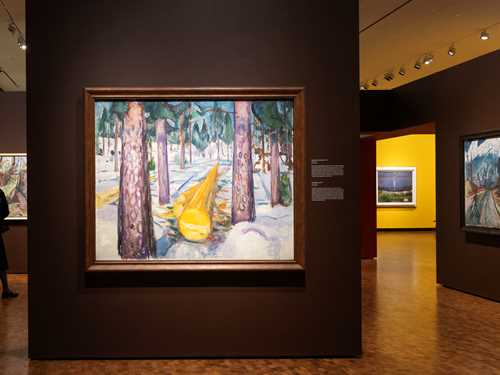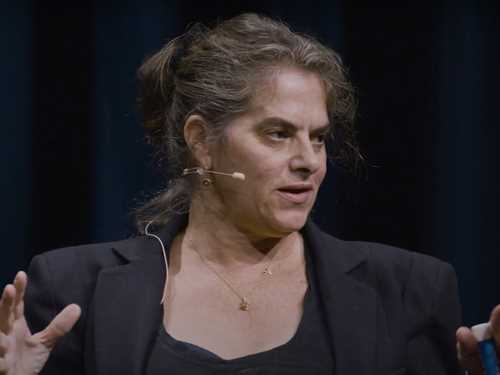– I think Munch is life-changing
Ali Smith has written a personal text for the exhibition catalogue for Trembling Earth, and this forms the basis of her conversation with the exhibition’s curator, Trine Otte Bak Nielsen. Below you can read their conversation, which took place at MUNCH 28.04.24.

Photo: Helge Brekke ©Munchmuseet
Trine Otte Bak Nielsen: Welcome to MUNCH, Ali. We are so happy to have you here.
Ali Smith: Oh, I am so happy to be here. I can't believe you asked me to write for you. I can't even believe I got to write about Munch. I think Munch is life-changing. I think his work is life-changing. I think the time I spent even with reproductions of Munch was life-changing. He is amazing. So, to be asked to do this thing has marked me physically, mentally, spiritually, metaphysically. Thanks.
TOBN: You're welcome. Before we start our talk, I should say a few words on the exhibition, to bring some context. The exhibition is the result of a long standing research collaboration between three institutions, the Barberini Museum in Potsdam and the Clark Art Institute in Williamstown, and we have been three curators Jill Lloyd, Jay Clark, and myself. Most importantly for us working on this project, has been to demonstrate nature’s central role in Edvard Munch’s work. As Munch himself wrote; “nature is” and I quote, “The Eternal great realm from which art derives its sustenance”. When we look at Munchs paintings, drawings and prints, nature is deliberately being explored and used to highlight different expressions, from dark mystical forests, moonlit nights by the shore, to the feeling of spring in the air with melting snow or fragile cosmic meetings in space. Nature is never a mere backdrop in Munch’s work. With our current understanding of humanity's relationship with nature, Munch’s visions appears more relevant than ever. In his universe, humans are not separated from nature, but instead inhabit the earth with an equal status to everything else. With this exhibition, we aim to show how Munch takes nature seriously, through his images where he presents humans and nature as inseparable. He even develops a worldview where he links humans with the earth and the cosmos as part of the same cycle, as part of the same whole. And it was early in the process that our editor Heidi Bale Amundsen, suggested we invite you, and everybody agreed that was a very good idea. First and foremost, because of your interest in visual arts through your work for many years, and also for bringing in nature as such a central part in your work. So when you said yes, we were very thrilled. And today I would like to start with talking a bit more in general about your work. I would like to start with stating, and I know many agrees with me on this one, that you embrace art in your texts in a way that is rarely seen among writers. From my art historical perspective, it's very important and very nice to feel that you actually look at the paintings and works of art that you are writing about. You look at the colours, brushstrokes, paint layers, and I would love to hear what role art plays in your work, and in your life, if it’s ever possible to divide the two.
AS: It's very funny to think that people writing about art might not be looking at the paintings. I'm not a critic, I was an academic for a little while, a terrible academic, I got things wrong all the time, I was not pedantic enough, using pedantic as a positive term there, I did not pay proper attention. But there is something about being in the presence of a work of any kind of art that asks you to be there. So it is about the question of presence, rather than your critical-self putting something between you and thinking, I'm going to think about this in a certain way. No, you have to be there, right there. Oh, look at that blue colour. You know, oh, what is that for a smudge? Is that figurative or abstract or both? And then the thing that is happening, the dialogue between us happens.
My partner is an artist, I love her. I love art. My very first love was an art student. I have loved artists and art. I think I love the art act. I think I'm in love with the thing in us which goes: No, no, create. Make something. Make something of this. No, let's look at it and see it again. Because that thing about being present makes everything new all the time. I think that's why, when I was an academic, I studied the modernists because they are about the making of something new. They have to break it to make it new, but it makes it new, and you have to put it together. You have to be there. Every form of art asks us to be in dialogue with it. I love Grace Paley, the American writer of short stories, who said ‘dialogue is life’. She understood that when we stop having dialogue, life itself is threatened. We need dialogue and dialogue is everything that art is.
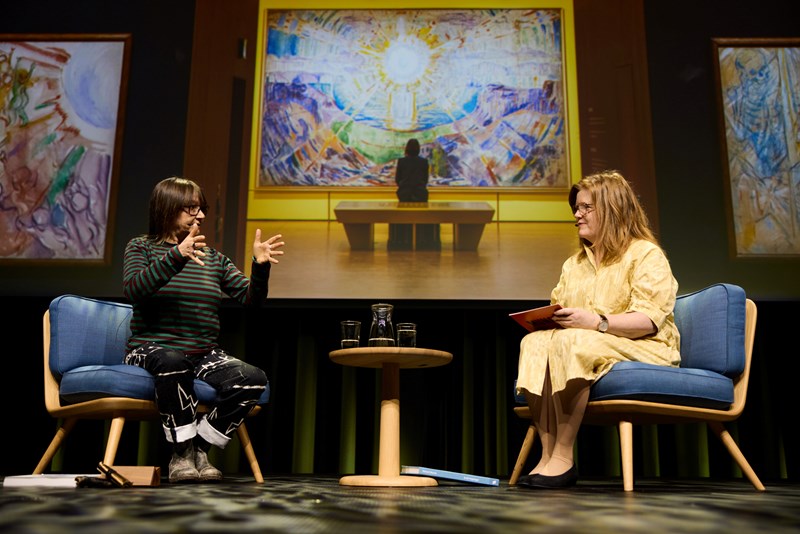
Photo: Helge Brekke ©Munchmuseet
TOBN: How do you think art change your stories, how do you find it fruitful to include art in your writing?
AS: Any writers here will know we work in the dark, we work with no feeling for what we can't see or understand yet. Sometimes that's terrifying. When I was working on my book Autumn, I was thinking about John Keats, the English poet who changed English lyric poetry by writing about autumn, and died so young and had such energy come through him. Just as I was thinking, ok, this book will probably be Keatsian in some way, I saw a work by an artist I'd never heard of, Pauline Boty. It was a tiny work, but very colourful – a version of Marilyn Monroe, both figurative and abstract. And I thought, Who is this artist? I looked her up and I thought this is fantastic, it’s a pop artist, a woman I’ve never heard, I thought why not? I looked up her life story, and realized that’s why her work stopped in 1966 because she died very young, and I thought, Oh, this is our tragic story. I realised that Autumn would also be about the energy that we leave behind us, that continues to give out energy. Her work is finally being properly re-evaluated. The energy that comes off it, standing in a room with her greens and her reds, wipes you clean.
So each of these books became about a woman who was an artist, it became about their work. Actually, Pauline Boty followed me around. I went downstairs one day thinking, I can't write this – this poor woman died so young. I can't write it. It's too sad. I went downstairs and I put the TV on to watch a programme called Flog It! [Where the public brings antiques to be valued - Ed]. I didn't even want to watch it. I just put the TV on to change my concentration. And there was some footage of Pauline Boty on the screen dancing in 1963 with David Hockney, a party at the Royal College of Art, and I was like, Oh, I see. You don't actually get the choice.
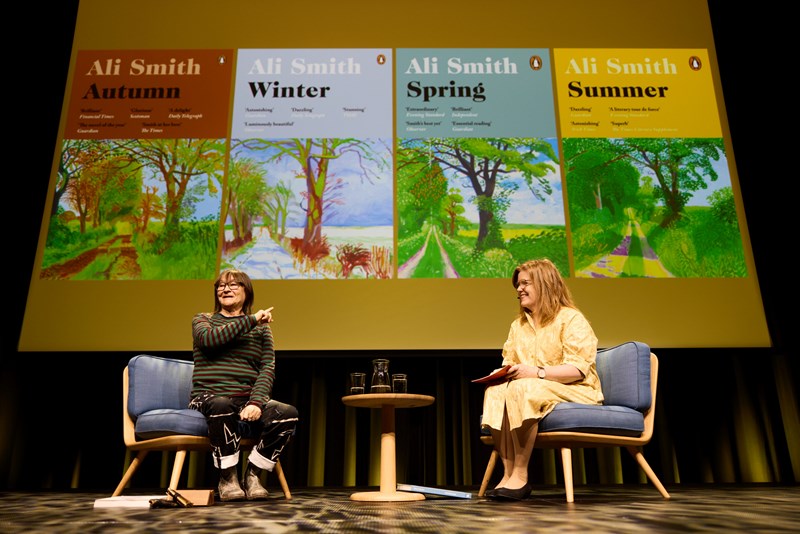
Photo: Helge Brekke ©Munchmuseet
TOBN: This seasonal quartet is a masterful example of how it seems that nature, in the same way as art, is an integral part of your work. You show us connections, how nature is interlinked, in a way like Munch also connects different parts of nature. You bring out the characteristics of trees, stones, the air, as part of the overall story. It’s never just a backdrop. How important would you say nature is in your work?
AS: I am Scottish. He is Norwegian. We know about nature right up against us. We know that in one day there will be four seasons, all happening at once. We can never get away from the impact of nature. So how do we live with nature? When I was young, there was a climate crisis happening that we didn't know about. And now we know it is happening. So a coming of age into a coming of knowledge means we have to face what has to change. We have to.
The interesting thing to me about Munch is that he already knows this, and that your exhibition says so and shows it and reveals it as you walk through the rooms of Trembling Earth you feel it tremble, you feel that he felt what was important about us; how we are made of landscape, we are Earth, air, water – that is what we are in the cosmos. And you see Munch come through the various stages which take you to the cosmos and allow you to realise you are bigger than your body, even bigger than the Earth itself, because it is connected beyond the Earth. It is so moving to see that. He is so contemporary, and we are catching up with him. It’s an amazing exhibition.
TOBN: Thank you. One thing I really like about the way you write, is how its personal and unfiltered – its you, Ali Smith who writes while looking at reproductions. This is how most people are introduced to Munch’s work, and by stating this in the first sentence – you familiarize the way you see Munch’s work – and at the same time state somekind of division, by thinking in layers – different realities, textures, surfaces, and I wonder what intrigues you about this approach?
AS: The screen is an extraordinary tool, and we are using it both really well and really badly at the moment. We have to learn how to use this tool, which separates us and yet gifts us both at once by putting something between us and reality, something between us and the real picture.
And we can use the screen as a form of memory and a form of seeing, but it separates us. It's a very useful tool, but we are using it to separate people in the world in a way that is really dangerous. And that's why social media is so important, so valuable and so tricky, because it asks that separation, it asks isolation, and at the same time we have to understand how to work in the reality of things. Otherwise we will lose the reality.
It’s the same with immersive art, you go to see it, and its all pixelated, and its all around you, but if you go and see the real thing, you are going to see the real thing. To stand in front of a Munch work. Reproductions is fine, you can see a lot in a reproduction, with new technology you can come really close to the paint level. But to stand in front of the monumental pictures in this gallery is a gift beyond belief. Yesterday we were in the monumental gallery, and there was a very small baby on the floor. The baby could not take his eyes off the paintings, it could not stop looking at The Mother, and could not stop turning to look at The Sun.
The thing that goes between us and reality is sometimes most valuably the art itself, the making of it. I'm very interested in how we use screens – is it the same in Norwegian? – the word screen also means something that keeps you apart. So it blocks you. A screen is something you can stand behind and take your clothes off, and nobody will see you. And yet a screen is the thing by which most people see the news, information, our lives, our memories. That is something that we as a species are going to have to solve pretty soon.
TOBN: Another quality I appreciate in your work is the way you question your own descriptions in your writing, when you're looking at art. And by doing that, you don’t state that there is one correct way of understanding it, or imply that you have understood the purpose of a painting. This is also important for us here at the museum: we don't try to say this is the correct way of understanding. There are so many different angles. How has this been important to you, to question what you see?
AS: I write because I do question what an authority is. I think I write precisely because I was an academic for some time and realise that authority is one take on things and that if we do not question the structures of things, then why are we here? If we do not question how something is made, then we can't change the structure. If we do not question, we will not move forward.
It's a very interesting experience being a novelist. The novel has authority and you have to go to some extent with the novel's authority. You have to ask that novel to be in dialogue with you and it has to ask you to be in dialogue with it. It's a bit like riding a horse. The thing is huge, and it can do what it likes. And yet there is an agreement between you. And the agreement is sometimes negotiable.
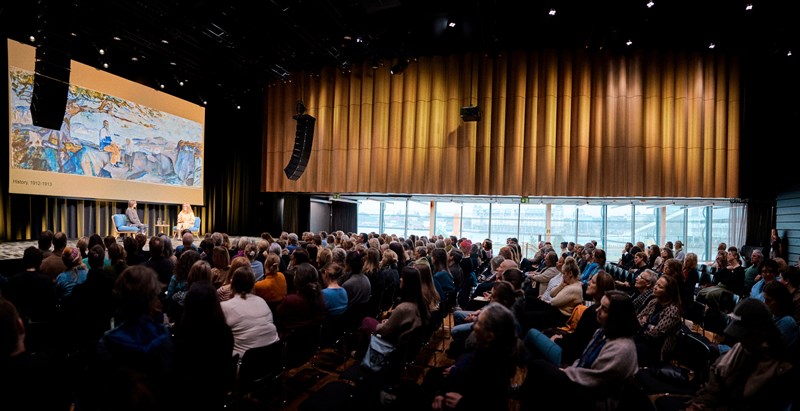
Photo: Helge Brekke ©Munchmuseet
(Questions from the audience)
Q: If you had to choose one from all these paintings, sit in front of it for three hours and then write about it, which one would you choose?
AS: That's easy: what I would do is I would write to Trine, and I would say, Send me without any context at all, just the name of a picture that Munch has made. And then she would send me the title. And then I would go away and write about it, having looked at it for three hours, because whatever I look at in Munch will let me do that. I could spend a whole life with one picture, and not know it. I think I could do it with anything that Munch made, because his work is astounding at every level. Even his earliest work all the way through everything. You could send me one title, and I could spend a life with that.
You read Middlemarch at the age of 60. And you've read it at 40. And you've read it at 20. And you know that it's a different book. But you know that it's not a different book, it's exactly the same. It's not like George Eliot has changed it. We have changed, but the book allows for us to change.
I fear for my own seasonal books. I wonder if they won't last – they're very attached to a time. But with an artwork, which is forever contemporary, like this exhibition reveals Munch to be, you're never not going to be at home with it in the real world.
Q: At this stage of your life, and with all the books you've done so far, where are you thinking about going and what do you foresee that could happen to us in the near future?
AS: At the moment our world is darker than I have ever seen. So the book I have been working on has been really interesting because story itself will not allow things to be totally dark; story is about enlightenment. It's always about the ways that narratives are working on us, and the ways that we need them to survive in the dark. That's what we humans did. We sat around the light of the fire and told stories. So this new book I've been working on is nearly finished. It is a departure for me. And I'm glad, because I needed a departure. But it's been up against the craziest times, for sure. With all the echoes of things that happened in my parents’ lifetime coming back, like those giant parents at the back of the Children in the Forest, leaning over us.
The title is an English word, Gliff. It sounds like a nonsense word, but it sounds like the word ‘glyph’. And glyph is the root of all language, the root of all architecture, the root of every mark we've ever made is a form of glyph. The mark we leave. So you've got a nonsense-sounding word, which actually means lots of things.
And then beyond that, I want to write something long about Mr. Munch. So that's where I am right now. But please, wish me luck.
Q: Can you tell us about the first time that you saw a Munch work in person?
AS: I can't remember. It must have been more than 20 years ago, around 2002, the first visit I made to Norway was with my translator and my publisher. We went to the old Munch Museum.
We walked through that building and I found out about his life. Just by being in front of those pictures. I saw the dark. I saw the loss. I saw the sick child and the apple tree. I saw both these things and I thought, Who on Earth is this painter who can do this? And they are related. They are the same: there is this fruitfulness that changes everything. There is this loss that we know at the heart of everything on Earth.
I put a print of the apple tree on my desk and it is still there. I'm looking at the apple tree and I think, just do the thing that the apple tree does: produce the astonishing fruit. With any luck it comes out as fruitful. So that's my first memory, really, of Munch – not The Scream. It is the relationship between the loss and the fruitfulness.
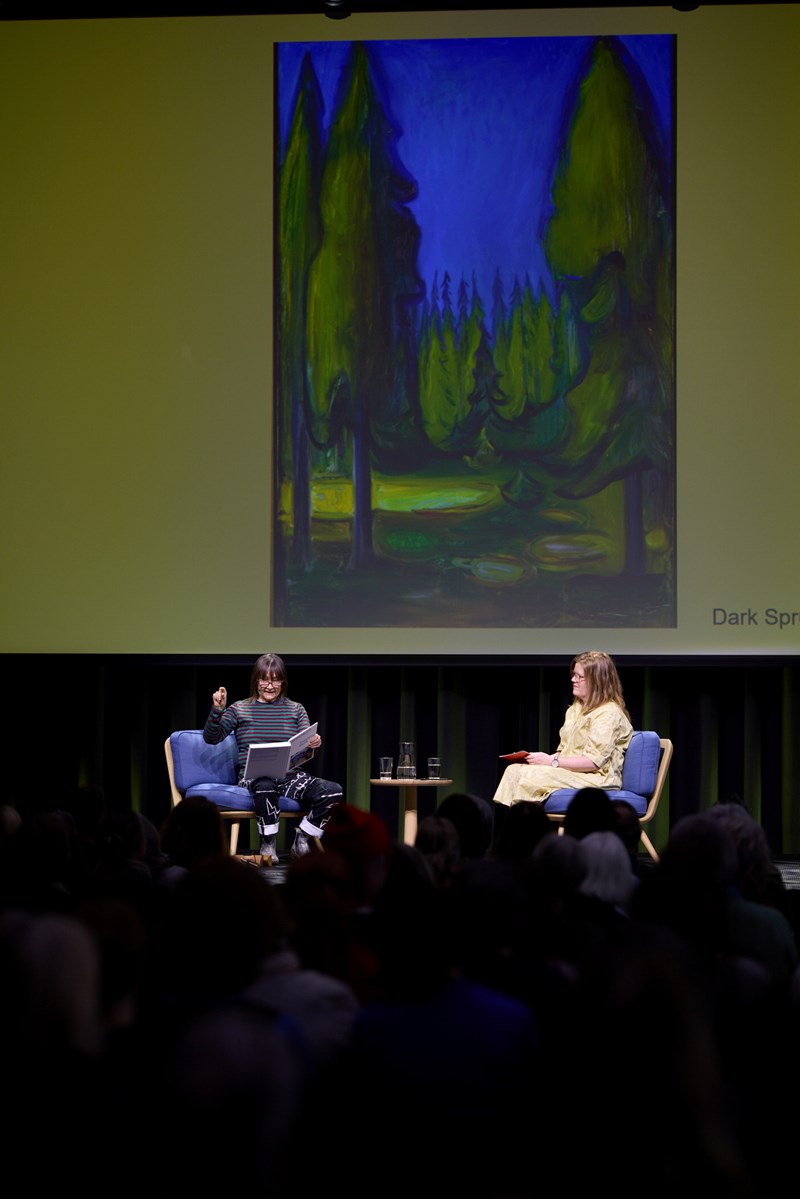
Photo: Helge Brekke ©Munchmuseet
Ali Smith was born in Inverness in 1962. She is the author of several novels and short story collections including, The Accidental, Hotel World, How to Be Both and the Seasonal Quartet. She has been four times shortlisted for the Booker Prize, has won the Goldsmiths Prize, Orwell Prize, Costa Best Novel Award and the Women’s Prize. Ali Smith lives in Cambridge.
Trine Otte Bak Nielsen is Cand.philol. in Art History from the University of Oslo. She has worked at MUNCH since 2014 and has curated exhibitions such as Goya and Munch. Modern Prophecies (2023), Satyricon & Munch (2022), Infinite (2021), Monumental (2021), Moonrise. Marlene Dumas & Edvard Munch (2018) and Vigeland+Munch. Behind the myths (2015).
